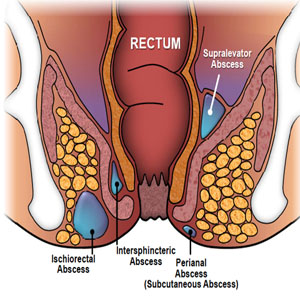What is Perianal Surgery?
It consists of group of surgeriea performd for anal pathology, like pile, fissure, fistula.

Treatment & Surgery
An anal fissure is a small cut or tears in the lining of the anus. The crack in the skin causes severe pain and some bright red bleeding during and after bowel movements. At times, the fissure can be deep enough to expose the muscle tissue underneath.
An anal fissure usually isn’t a serious condition. It can affect people of all ages, and it’s often seen in infants and young children since constipation is a common problem in these age groups.
In most cases, the tear heals on its own within four to six weeks. In cases where the fissure persists beyond eight weeks, it’s considered chronic.
Certain treatments can promote healing and help relieve discomfort, including stool softeners and topical pain relievers.
If an anal fissure doesn’t improve with these treatments, you may need surgery. Or your doctor may need to look for other underlying disorders that can cause anal fissures.
An anal fissure may cause one or more of the following symptoms:
- a visible tear in the skin around your anus
- a skin tag, or small lump of skin, next to the tear
- sharp pain in the anal area during bowel movements
- streaks of blood on stools or on toilet paper after wiping
- burning or itching in the anal area
Hemorrhoids, also called piles, happen when clusters of veins in your rectum or anus get swollen (or dilated). When these veins swell, blood pools and cause the veins to expand outward into the membranes around your rectal and anal tissue. This can become uncomfortable or painful.
Hemorrhoids aren’t always visible. But when they expand, they can look like red or discolored bumps or lumps.
Types Of Hemorrhoids:
Internal hemorrhoids :
Internal hemorrhoids are found in your rectum. They can’t always be seen because they’re too deep in your anus to be visible.
Internal hemorrhoids aren’t normally serious and tend to go away on their own.
Sometimes internal hemorrhoids can swell and stick out of your anus. This is known as a prolapsed hemorrhoid.
External hemorrhoids
External hemorrhoids occur on your anus, directly on the surface of where your bowel movements come out. They’re not always visible but are sometimes seen as lumps on the anal surface.
External hemorrhoids aren’t usually a serious medical issue. But see your doctor if they cause pain or discomfort that interrupts your daily life.
The symptoms of external hemorrhoids are essentially the same as those of internal ones. But since they’re located on the outside of your rectal area, you may feel more pain or discomfort when you sit down, do physical activities, or have a bowel movement.
The rectum and anus are surrounded by glands or cavities. If bacteria, fecal matter, or foreign matter get into the cavities, they can become infected and fill with pus.
If the infection grows worse, the gland may develop a tunnel through the nearby tissue and crease a fistula.
In addition to rectal pain, perianal or perirectal abscess can cause:
- redness of the skin around the anus
- fever
- bleeding
- swelling around the anus and in the rectum
- painful urination
- difficulty starting a urine stream
An anal fistula is a tunnel that runs from inside the anus — the hole your body uses to get rid of solid waste — to somewhere in the skin around it. It usually follows an infection that didn’t heal the right way. Your doctor can repair the fistula, but you’ll need surgery for that.
The most common symptoms are:
- Pain
- Redness
- Swelling around your anus
You might also notice:
- Bleeding
- Painful bowel movements or urination
- Fever
- A foul-smelling liquid oozing from a hole near your anus
